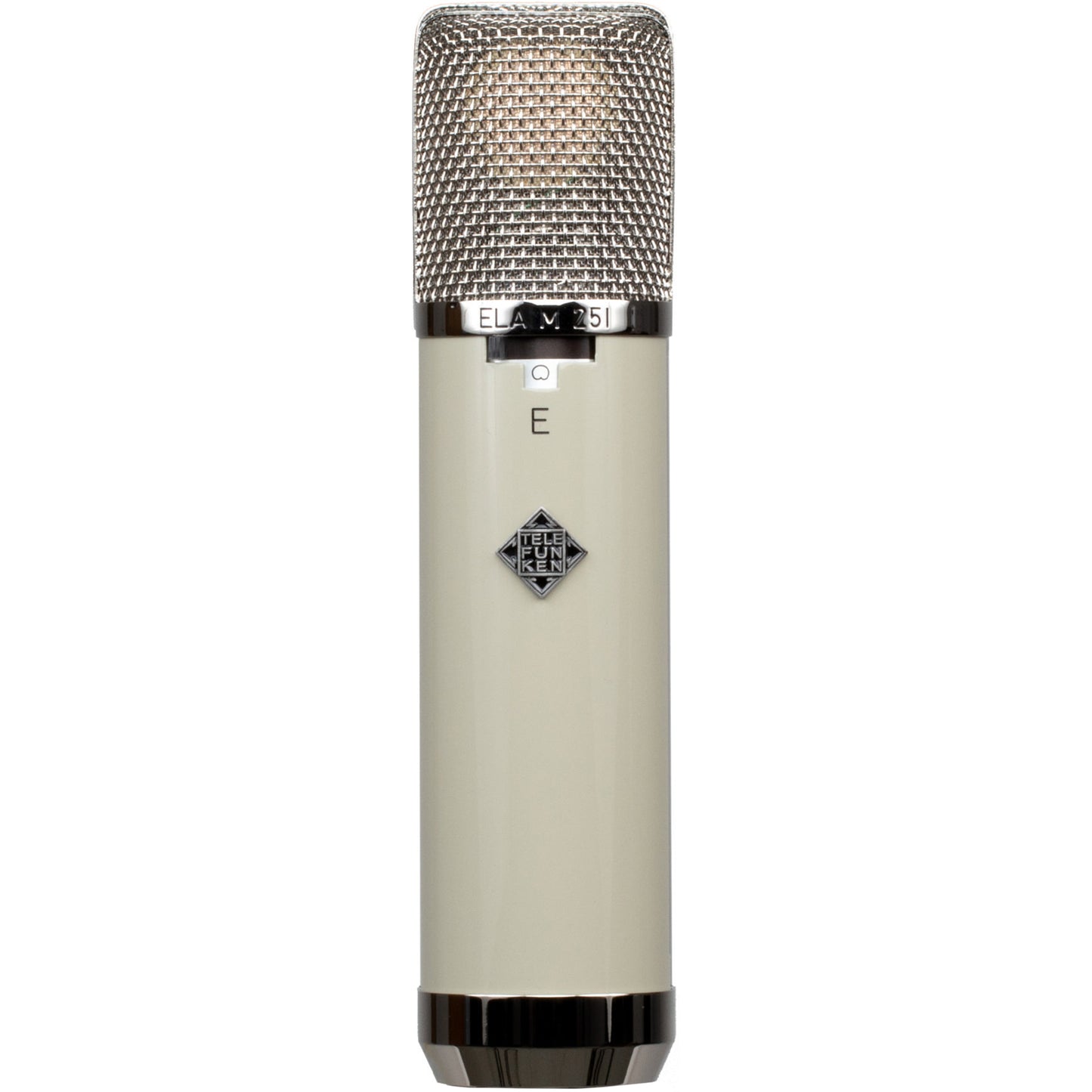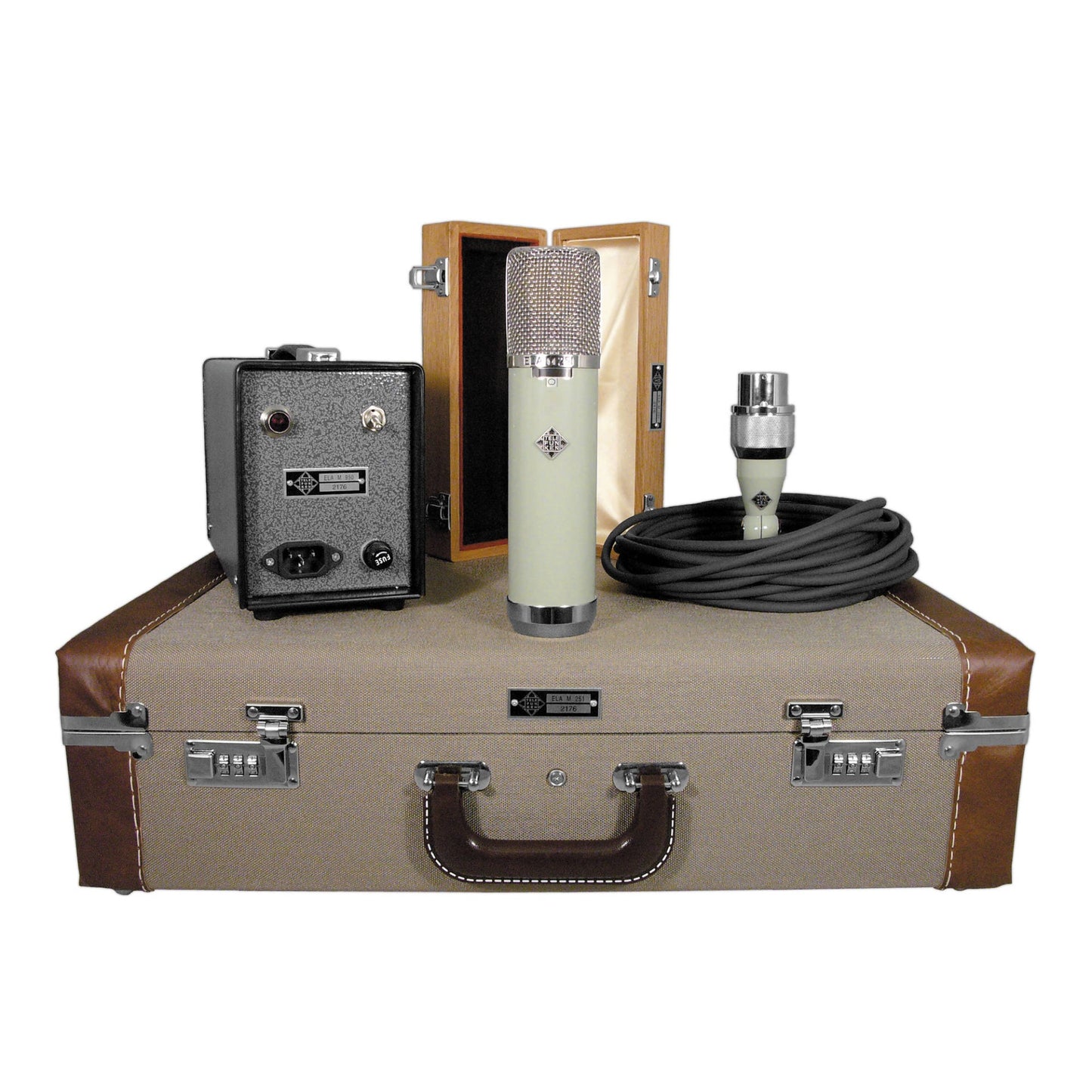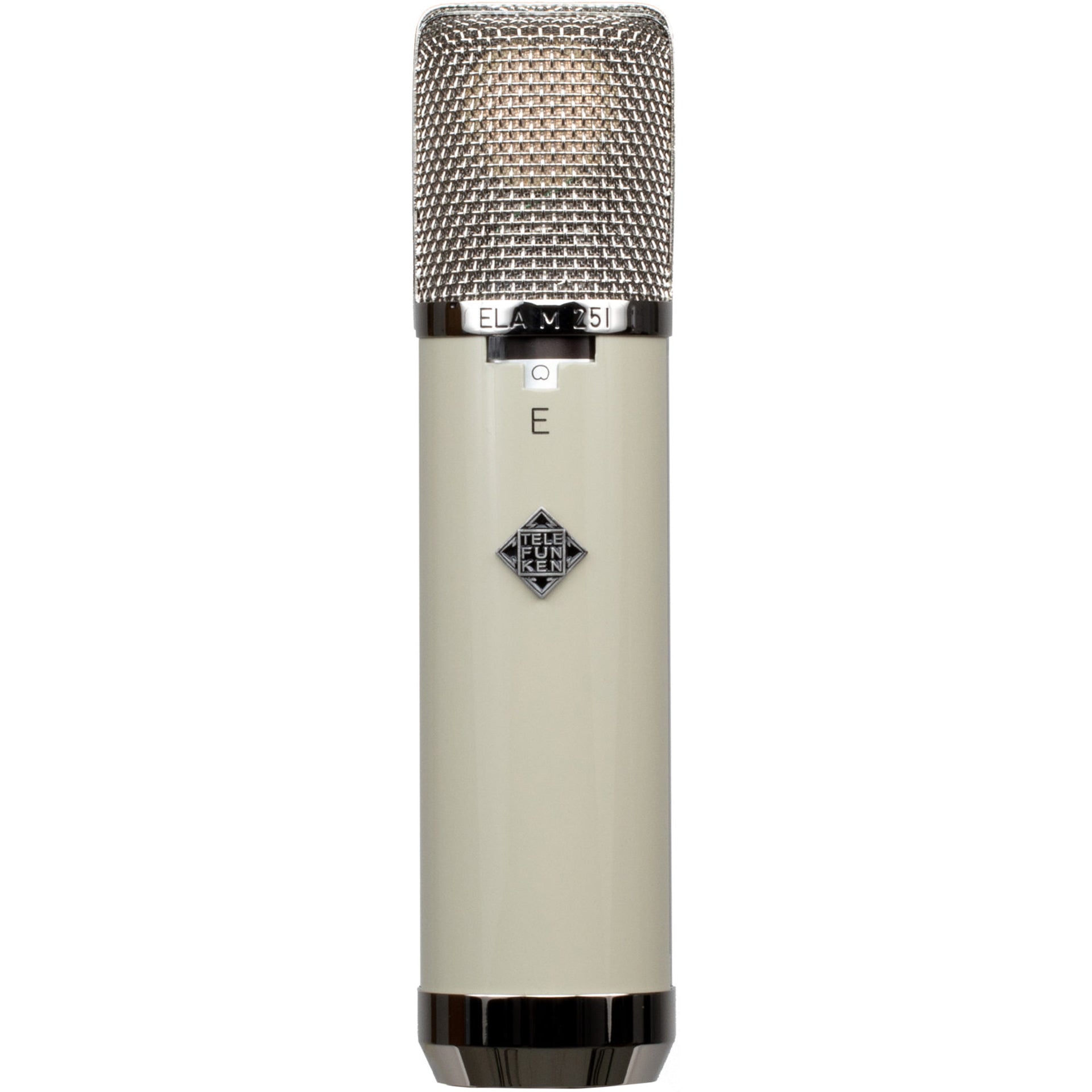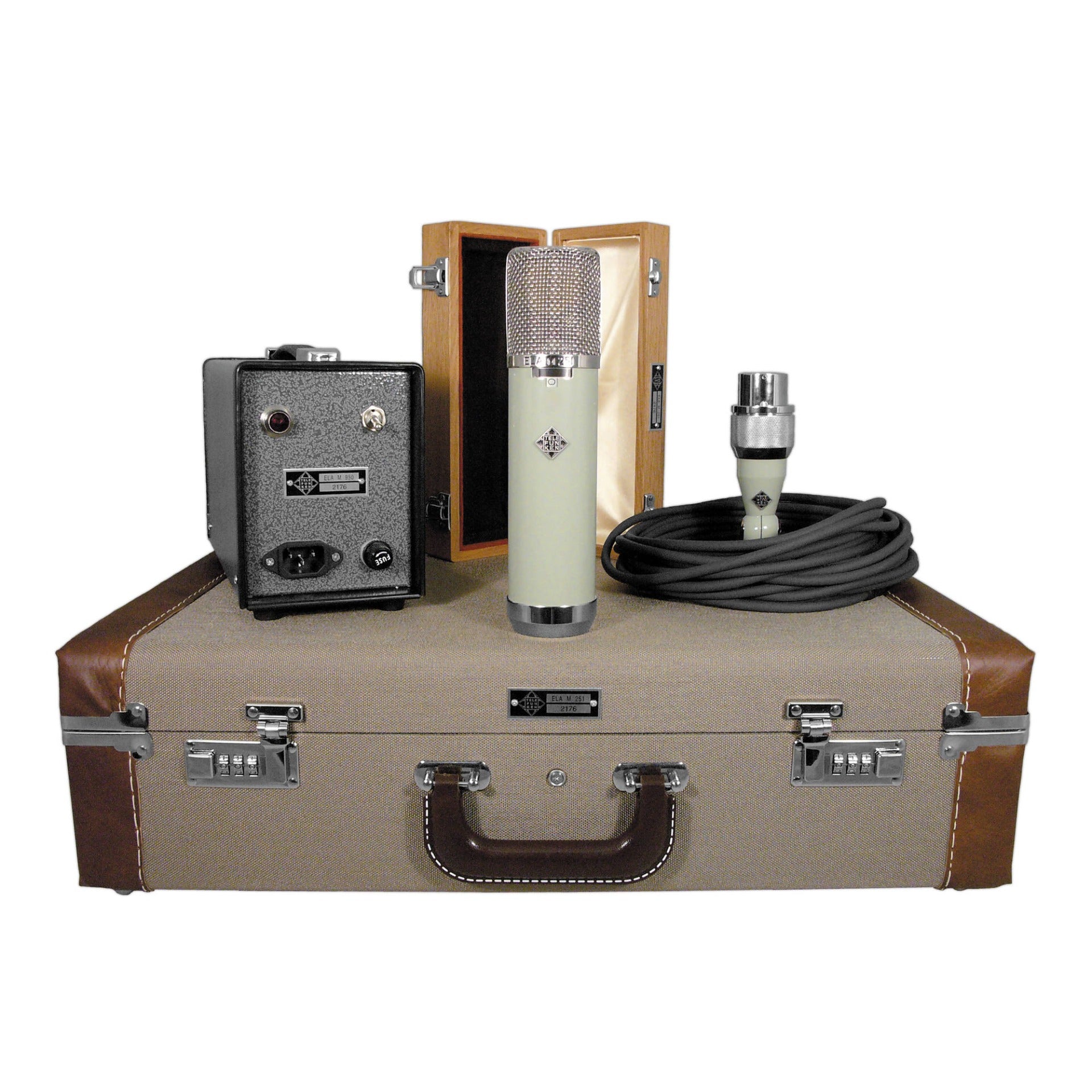

- Details
- Tech Specs
- Reviews
Arguably one of the most beautiful microphones ever produced, the TELEFUNKEN ELA M 251E has been featured on countless hits and classic recordings over the decades. By virtue of its smooth, yet present and "open" sonic character, the ELA M 251E large diaphragm tube microphone is a true classic with very few rivals. Today, prime examples of vintage ELA M 250 / 251 [both "E" and "non E"] microphones have become rare and highly sought after jewels, commanding tens of thousands of dollars on the vintage market. TELEFUNKEN Elektroakustik's historic recreations of the ELA M 251E exemplify the best qualities of the finest specimens of these legendary beasts, and while more expensive than most modern microphones, they are true to the heritage of their 50+ year old brethren.
The TELEFUNKEN ELA M 251E includes an edge terminated, dual backplate CK12 capsule capable of cardioid, omnidirectional and bidirectional polar patterns, a New Old Stock 6072a vacuum tube and a Haufe 14:1 ratio output transformer (the same found in the AKG Acoustics GmbH C12). Each reissue is 100% true in every detail to the original [the parts are interchangeable with the 50+ year old originals], and will deliver the same sonically opulent response that made the ELA M 251E one of the world's most sought after recording tools.
Each ELA M 251E microphone system comes complete with M950E power supply, M850E 25' quad-shielded Accusound ACX-7 tube microphone cable, FC50 locking flight case and WB50 wooden microphone box.
HISTORY
The TELEFUNKEN ELA M 250 / 251 was originally sold in two variations: the "ELA M 250E / 251E" version utilized a 6072a tube, while the "ELA M 250 / 251" version contained a TELEFUNKEN AC701 tube. The "no-suffix" microphones were built to satisfy the standardized requirements of the German and Austrian national broadcast systems. While both versions of these microphones have achieved legendary stature in the modern recording industry, the road to achieving this legendary status was far from instantaneous.
In 1947 Neumann GmbH first built the U47 microphone. From 1947 to 1958 TELEFUNKEN GmbH used their established global distribution network for the products produced by Neumann GmbH, which were sold under the TELEFUNKEN name with a TELEFUNKEN logo badge.
In 1958 when Neumann GmbH notified TELEFUNKEN GmbH that they had decided to not renew their distribution contract, TELEFUNKEN reached out to AKG Acoustics about the possibility of AKG creating a "U47-like" model for TELEFUNKEN to plug into their global distribution network.
This U47-esque microphone was to be known as the ELA M 250. Like the U47 this new microphone featured the polar pattern selection (cardioid and omnidirectional) switch on the head of the microphone. Around 1958 Neumann GmbH also released their U48 microphone, which featured cardioid and bidirectional pattern selection. The TELEFUNKEN ELA M 251 was an amalgam of these two microphones as it was capable of switching between all three patterns (cardioid, omnidirectional, and bidirectional).
The switch housing at the base of the capsule assembly is where the similarity between the Neumann GmbH U47/48 and the ELA M 250 / 251 microphone series ends.
While the C12 accomplished pattern selection with an outboard switching device that was connected to the power supply, the ELA M 250 / 251 eliminated that addition to the system and minimized both the quantity of wires that had to run to the microphone as well as the expense of the external pattern selection box. The design engineers at AKG Acoustics also came up with another very handy feature, which was the capability to minimize the time necessary to accomplish "field repairs" of the microphone. Both the C12 and U47/48 microphones require a fair bit of knowledge, a steady hand, as well as a couple of screwdrivers to get to the internal workings of the mic
In order to perform a "field repair" of the ELA M 251E, one simply needed to unscrew the base ring from the bottom of the mic and the metal body tube would slide right off (no tools necessary!!). Once the body tube was removed either the capsule or the amplifier could be replaced in under a minute, saving precious time during an expensive broadcast or orchestral recording session.
The amplifier in the ELA M 250 / 251 series is housed in a molded plastic enclosure. The capsule and head grill assembly is held in place by two metal struts that run up the exterior of the amplifier housing. By implementing this system, either of these critical components could be replaced in seconds and the session could continue while the faulty system element could be sent to the technical shop for in-depth repair. This convenience was something the broadcasters of the time found to be a major plus as they had thousands of dollars of musicians sitting around for the live music broadcasts of the day. Any time saved cut down on the expense of the session, and added to the quality of the broadcast.
Unfortunately for TELEFUNKEN GmbH, these field replacement provisions also proved to be a sales impediment outside of the orchestral recording world as the plastic bits employed in these microphones added significant cost to the construction of the microphones.
The added cost made them markedly more expensive at the time than the Neumann GmbH and AKG Acoustics GmbH products, thus the non-government owned facilities of the time did not adopt these systems as readily as TELEFUNKEN GmbH would have liked. It is thought that fewer than 3700 total original ELA M systems were built from 1960 to 1965 when TELEFUNKEN GmbH discontinued sales of the microphone.
Today, prime examples of vintage ELA M 250 / 251 [both "E" and "non E"] microphones have become rare and highly sought after jewels, commanding tens of thousands of dollars on the vintage market. TELEFUNKEN Elektroakustik's historic recreations of the ELA M 251E exemplify the best qualities of the finest specimens of these legendary beasts, and while more expensive than most modern microphones, they are true to the heritage of their 50+ year old brethren.
Today TELEFUNKEN Elektroakustik has brought advancement to this classic system through the development of the CK-13™ capsule. While the CK-13 can be fit to any existing ELA M 250 /251 system it can also be found in the ELA M 251 T which is available through your favorite reseller via the "custom shop.”
| Product Name | Telefunken ELA M 251e Large Diaphragm Tube Microphone |
|---|---|
| Brand | Telefunken |
| Condition | New |
| MPN | SYTM-003 |
| UPC | 899051002213 |
| Shipping Option | Free Shipping to the Continental U.S. |
| Type | Condenser Pressure Gradient |
| Capsule | CK12 - 25 mm Edge Terminated Diaphragm |
| Frequency Range | 20Hz - 20kHz, ± 3 dB |
| Polar Pattern | Cardioid, Omnidirectional and Bidirectional |
| Sensitivity | 17mV/pa ± 1 dB |
| THD at 1kHz at 1Pa | <0.2% |
| Output Impedance | 200 Ω |
| Maximum SPL | 130 dB |
| Non Linear Distortion | Less than or equal to 0.5% at 100 dyne / cm sq |
| Self Noise (Amplifier) | 9dBA |
| Tube Type | GE JAN 6072a (NOS) |
| Power Supply | M 950E PSU - 7 Pin Female XLR Input, 3 Pin Male XLR Output |
| Size | 216 mm L x 50 mm Dia |
| Weight | 596 g |
| Supply Current | <1mA, <150mA |
| Supplied Accessories | Locking flight case, power supply, wooden mic box, clasping shock mount, 25' Accusound quad-shielded cable with swivel connector |
Telefunken ELA M 251e Large Diaphragm Tube Microphone
Arguably one of the most beautiful microphones ever produced, the TELEFUNKEN ELA M 251E has been featured on countless hits and classic recordings over the decades. By virtue of its smooth, yet present and "open" sonic character, the ELA M 251E large diaphragm tube microphone is a true classic with very few rivals. Today, prime examples of vintage ELA M 250 / 251 [both "E" and "non E"] microphones have become rare and highly sought after jewels, commanding tens of thousands of dollars on the vintage market. TELEFUNKEN Elektroakustik's historic recreations of the ELA M 251E exemplify the best qualities of the finest specimens of these legendary beasts, and while more expensive than most modern microphones, they are true to the heritage of their 50+ year old brethren.
The TELEFUNKEN ELA M 251E includes an edge terminated, dual backplate CK12 capsule capable of cardioid, omnidirectional and bidirectional polar patterns, a New Old Stock 6072a vacuum tube and a Haufe 14:1 ratio output transformer (the same found in the AKG Acoustics GmbH C12). Each reissue is 100% true in every detail to the original [the parts are interchangeable with the 50+ year old originals], and will deliver the same sonically opulent response that made the ELA M 251E one of the world's most sought after recording tools.
Each ELA M 251E microphone system comes complete with M950E power supply, M850E 25' quad-shielded Accusound ACX-7 tube microphone cable, FC50 locking flight case and WB50 wooden microphone box.
HISTORY
The TELEFUNKEN ELA M 250 / 251 was originally sold in two variations: the "ELA M 250E / 251E" version utilized a 6072a tube, while the "ELA M 250 / 251" version contained a TELEFUNKEN AC701 tube. The "no-suffix" microphones were built to satisfy the standardized requirements of the German and Austrian national broadcast systems. While both versions of these microphones have achieved legendary stature in the modern recording industry, the road to achieving this legendary status was far from instantaneous.
In 1947 Neumann GmbH first built the U47 microphone. From 1947 to 1958 TELEFUNKEN GmbH used their established global distribution network for the products produced by Neumann GmbH, which were sold under the TELEFUNKEN name with a TELEFUNKEN logo badge.
In 1958 when Neumann GmbH notified TELEFUNKEN GmbH that they had decided to not renew their distribution contract, TELEFUNKEN reached out to AKG Acoustics about the possibility of AKG creating a "U47-like" model for TELEFUNKEN to plug into their global distribution network.
This U47-esque microphone was to be known as the ELA M 250. Like the U47 this new microphone featured the polar pattern selection (cardioid and omnidirectional) switch on the head of the microphone. Around 1958 Neumann GmbH also released their U48 microphone, which featured cardioid and bidirectional pattern selection. The TELEFUNKEN ELA M 251 was an amalgam of these two microphones as it was capable of switching between all three patterns (cardioid, omnidirectional, and bidirectional).
The switch housing at the base of the capsule assembly is where the similarity between the Neumann GmbH U47/48 and the ELA M 250 / 251 microphone series ends.
While the C12 accomplished pattern selection with an outboard switching device that was connected to the power supply, the ELA M 250 / 251 eliminated that addition to the system and minimized both the quantity of wires that had to run to the microphone as well as the expense of the external pattern selection box. The design engineers at AKG Acoustics also came up with another very handy feature, which was the capability to minimize the time necessary to accomplish "field repairs" of the microphone. Both the C12 and U47/48 microphones require a fair bit of knowledge, a steady hand, as well as a couple of screwdrivers to get to the internal workings of the mic
In order to perform a "field repair" of the ELA M 251E, one simply needed to unscrew the base ring from the bottom of the mic and the metal body tube would slide right off (no tools necessary!!). Once the body tube was removed either the capsule or the amplifier could be replaced in under a minute, saving precious time during an expensive broadcast or orchestral recording session.
The amplifier in the ELA M 250 / 251 series is housed in a molded plastic enclosure. The capsule and head grill assembly is held in place by two metal struts that run up the exterior of the amplifier housing. By implementing this system, either of these critical components could be replaced in seconds and the session could continue while the faulty system element could be sent to the technical shop for in-depth repair. This convenience was something the broadcasters of the time found to be a major plus as they had thousands of dollars of musicians sitting around for the live music broadcasts of the day. Any time saved cut down on the expense of the session, and added to the quality of the broadcast.
Unfortunately for TELEFUNKEN GmbH, these field replacement provisions also proved to be a sales impediment outside of the orchestral recording world as the plastic bits employed in these microphones added significant cost to the construction of the microphones.
The added cost made them markedly more expensive at the time than the Neumann GmbH and AKG Acoustics GmbH products, thus the non-government owned facilities of the time did not adopt these systems as readily as TELEFUNKEN GmbH would have liked. It is thought that fewer than 3700 total original ELA M systems were built from 1960 to 1965 when TELEFUNKEN GmbH discontinued sales of the microphone.
Today, prime examples of vintage ELA M 250 / 251 [both "E" and "non E"] microphones have become rare and highly sought after jewels, commanding tens of thousands of dollars on the vintage market. TELEFUNKEN Elektroakustik's historic recreations of the ELA M 251E exemplify the best qualities of the finest specimens of these legendary beasts, and while more expensive than most modern microphones, they are true to the heritage of their 50+ year old brethren.
Today TELEFUNKEN Elektroakustik has brought advancement to this classic system through the development of the CK-13™ capsule. While the CK-13 can be fit to any existing ELA M 250 /251 system it can also be found in the ELA M 251 T which is available through your favorite reseller via the "custom shop.”
| Product Name | Telefunken ELA M 251e Large Diaphragm Tube Microphone |
|---|---|
| Brand | Telefunken |
| Condition | New |
| MPN | SYTM-003 |
| UPC | 899051002213 |
| Shipping Option | Free Shipping to the Continental U.S. |
| Type | Condenser Pressure Gradient |
| Capsule | CK12 - 25 mm Edge Terminated Diaphragm |
| Frequency Range | 20Hz - 20kHz, ± 3 dB |
| Polar Pattern | Cardioid, Omnidirectional and Bidirectional |
| Sensitivity | 17mV/pa ± 1 dB |
| THD at 1kHz at 1Pa | <0.2% |
| Output Impedance | 200 Ω |
| Maximum SPL | 130 dB |
| Non Linear Distortion | Less than or equal to 0.5% at 100 dyne / cm sq |
| Self Noise (Amplifier) | 9dBA |
| Tube Type | GE JAN 6072a (NOS) |
| Power Supply | M 950E PSU - 7 Pin Female XLR Input, 3 Pin Male XLR Output |
| Size | 216 mm L x 50 mm Dia |
| Weight | 596 g |
| Supply Current | <1mA, <150mA |
| Supplied Accessories | Locking flight case, power supply, wooden mic box, clasping shock mount, 25' Accusound quad-shielded cable with swivel connector |
- Choosing a selection results in a full page refresh.
- Opens in a new window.


